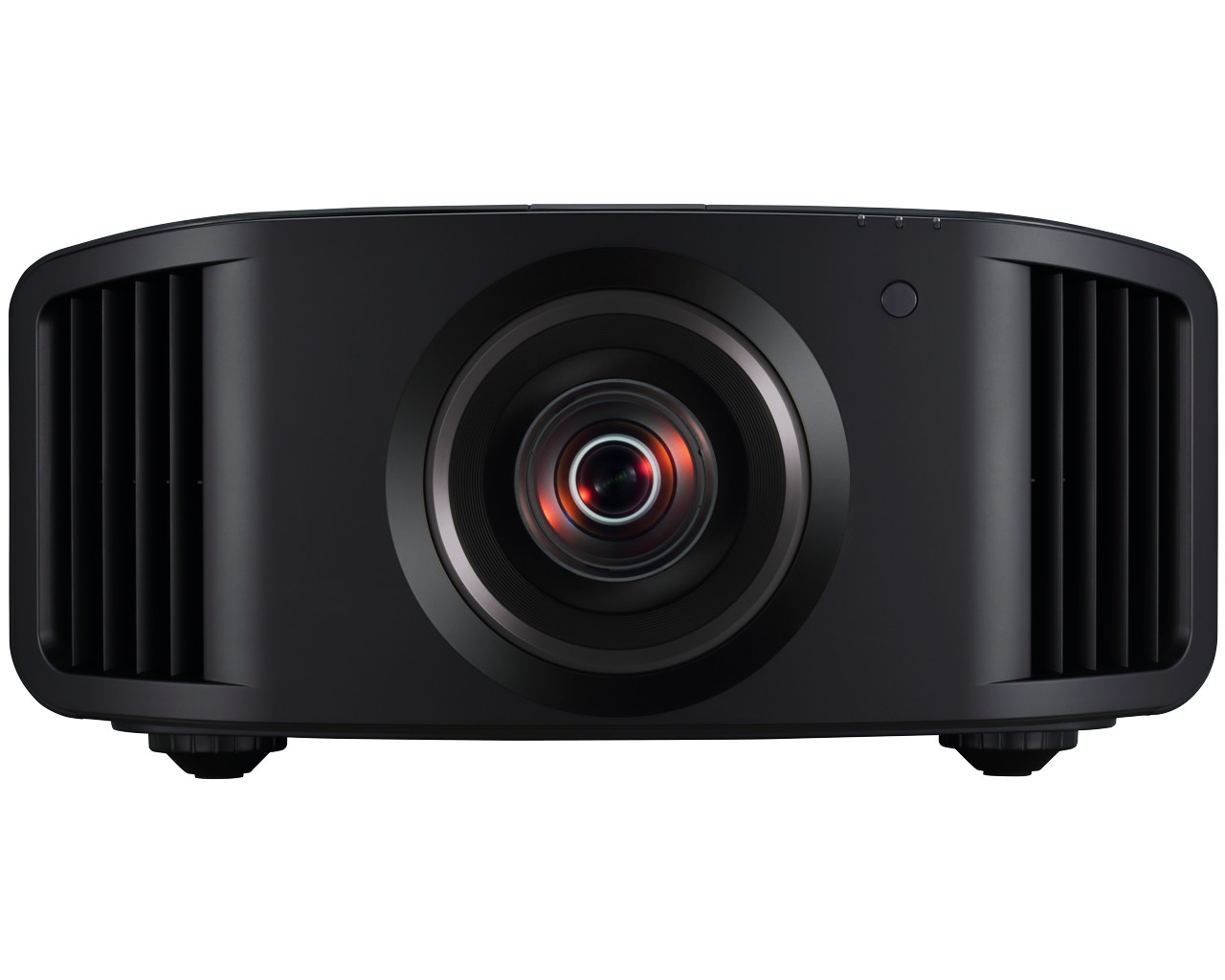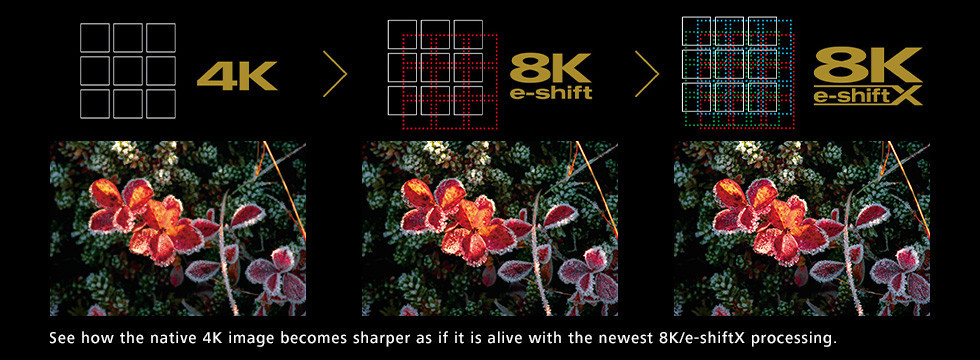



























£14,999.00*
- Light Brightness 2,700 Lumen
- Resolution 4096 x 2160 4K UHD
- Aspect Ratio 16:9
- Operating noise 24 dB


Product information
More brightness and longevity thanks to the BLU-Escent laser
A key factor in the performance of the D-ILA projector is the BLU-Escent laser with blue laser diodes, which achieves 2,700 lumens in the DLA-NZ800 and is designed for a service life of at least 20,000 operating hours.000 operating hours.
Highlights:
- 3rd generation of the 0.69-inch D-ILA panel with native 4K resolution (4096 x 2160)
- 2nd generation 8K/e-shiftX technology for image reproduction with 8K resolution
- New BLU-Escent laser light unit
- High light output of 2.700 lumens for true-colour and dynamic images
- All-glass lens with 65 mm diameter consisting of 17 elements in 15 groups
- Native contrast ratio of 100,000:1 leads to a dynamic contrast ratio of ∞ : 1
- 2 HDMI inputs (48 Gpbs, HDCP 2.3) for signals up to 8K60P and 4K120P
Gen2 8K/e-shiftX realised
picture playback with 8K resolution
The 2nd generation of JVC's own 8K resolution
Picture playback with 8K resolution. The second generation of JVC's proprietary 8K/e-shiftX technology doubles the resolution of a 4K signal by shifting each frame by 0.5 pixels in all four directions (left, right, up, down) to achieve pixel-perfect 8K resolution. The new generation of 8K scaling improves the projector's sharpness performance and ensures an incredible level of detail even with 8K sources.
Fantastic black level and high light output guarantee realistic image projection
The third generation of the 0.69-inch 4K D-ILA chip offers an outstanding contrast ratio that, in combination with the dynamic laser light control, which analyses the incoming video signal to automatically adjust the amount of light emitted, can achieve a dynamic contrast ratio of ∞:1 by switching off the light source completely in extremely dark scenes. As a result, images can be projected that come extremely close to human perception. The new algorithm also allows the laser to be controlled more precisely in order to optimise individual image adjustments.

8K60p input for ultra-high-resolution 8K signals
4K120p input optimised for video games
The new D-ILA models support high-resolution video signals up to 48Gbps 8K60p. By using highly integrated microchips of the latest design, the enormous data volumes of an 8K signal can be processed and displayed correctly. The result is detailed, extremely realistic video images with a full colour and contrast range. Thanks to the 4K120p input with low latency mode, the delay time during image processing is so short that optimum synchronicity of operator operation, image display and sound is guaranteed even in 4K games.

2nd generation Frame Adapt HDR for more dynamic range and colour depth in HDR content
The 2nd generation Frame Adapt HDR function permanently analyses the maximum brightness of each image and each individual scene of an HDR10 film, ensuring dynamic adjustment of brightness, colour and sharpness of detail in real time. The tone mapping algorithm developed by JVC has been completely revised to achieve an HDR display with higher colour depth and resolution.
Deep Black Tone Control
The new Deep Black Tone Control function adjusts the black level of dark scenes in Frame Adapt HDR mode so that night scenes appear much more realistic. This function optimises the dynamic range of the new 4K D-ILA devices and delivers a greater contrast range than ever before.
HDR drastically improves realistic image display
When it comes to reproducing the rich information of HDR content, including the enormous brightness range, extended BT.2020 colour space and 10-bit gradation, you should rely on one of the new D-ILA projectors. These models support all HDR formats including HDR10 for UHD Blu-ray and streaming, HLG for broadcasting and the new HDR10+ format with dynamic metadata compatibility. In combination with the higher light output and greater contrast, HDR films become an unforgettable cinema experience.
The Frame Adapt HDR function ensures dynamic adaptation of HDR10 content with high image resolution. It analyses each frame of the HDR10 content in real time and adjusts the dynamic range. In addition, the display of brightness levels and colour depth has been increased from 12 to 18 bits. Frame Adapt HDR ensures extremely precise reproduction of all brightness and colour shades of scenes with a wide variety of lighting situations.
- The Theater Optimizer function, in conjunction with Frame Adapt HDR, permanently ensures the optimum brightness and colour display in relation to the screen size and gain factor used. Brighter and more dynamic HDR images thanks to HDR Quantizer function with new Auto (Wide) Level mode.
- "Auto Tone Mapping" function for optimal display of HDR10 content by automatically adapting to the mastering data
- New FILMMAKER MODE™ for faithful reproduction according to the producer's intention.
- Clear Motion Drive ensures smooth motion display up to 4K60P (4:4:4) and has been significantly improved in the accuracy of moving image compensation.
- ISF C3 mode (Certified Calibration Controls) for optimum calibration for specific projection environments
- 6-axis colour management system
- Installation mode allows optics settings, pixel adjustment, masking, screen adjustment, installation situation, keystone correction, aspect ratio and anamorphic mode to be saved for different situations.
- The extended colour space exceeds DCI P3 and produces lifelike images with rich colours
- DML (Display Mastering Luminance) controls the dynamic range of the image for optimal HDR display.
- New "Vivid" image mode for SDR images
- With an optical sensor and proprietary software*, an optimal calibration can be performed in a few simple steps to adjust the changes in optical properties caused by the installation situation of the projector. Auto-calibration optimises all essential elements of the image, including colour balance, gamma properties, colour space and colour control.
- Auto-calibration with optical sensor
- Wireless transmission for 3D projection: Optional wireless transmission system consisting of the PK-AG3 battery-powered 3D glasses and the PK-EM2 3D sync transmitter
Technical data
| Name | JVC DLA-NZ800 Projector, 4096 x 2160 4K UHD, 2700 Lumen |
|---|---|
| Article number | 1000032457 |
| GTIN/EAN | 4975769480126 |
| Manufacturer SKU | DLA-NZ800 |
| Lens included | Yes |
| Model name | DLA-NZ800 |
| Projection Distance | Long Throw |
| Brand | JVC |
| Product Type | Projector |
| Product Series | JVC NZ8Series |
| Application | Installation projectors |
| Projector Type | D-ILA |
| Projector lamp type | Laser |
| ANSI Lumen | 2,700 ANSI Lumen |
| Resolution | 4096 x 2160 4K UHD |
| Aspect Ratio | 16:9 |
| Contrast Ratio | 100,000 :1 |
| Operating noise | 24 dB |
| Lamp life | 20,000 Hour |
| Minimum Projection Distance | 280 cm |
| Maximum Projection Distance | 1,380 cm |
| Minimum Projection Ratio | 1.43 |
| Maximum Projection Ratio | 2.92 |
| Minimum Lens-Shift Horizontal | -34% |
| Maximum Lens-Shift Horizontal | 34% |
| Minimum Lens-Shift Vertical | -80% |
| Maximum Lens-Shift Vertical | 80% |
| Inputs | 1x 3,5mm Jack , 1x Ethernet , 1x RS232 , 2x HDMI |
| Features | HDR , HDR10+ |
| Product width | 50 cm |
| Product height | 23.4 cm |
| Product depth | 50.5 cm |
| Weight | 23.1 kg |
| Colour | Black |
| Delivery contents | Power cable , Remote control |
| Condition | New |
| Warranty | 24 Month |
| Warranty type | Bringin service Service and support information |
Projection distance calculator
Contact our experts for help!
Image size:
Format
Format
Product safety
| Person responsible for the EU |
|---|
| JVCKENWOOD Deutschland GmbH |
| Konrad-Adenauer-Allee 1-11 |
| 61118 Bad Vilbel |
| Germany |
| info@kenwood.de |



